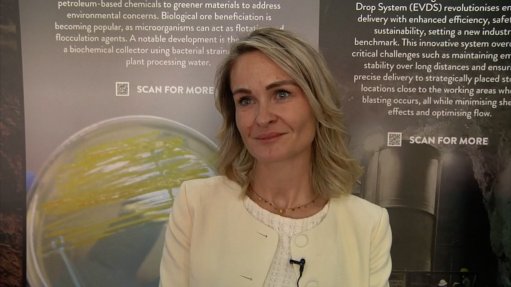Decarbonisation efforts in mining fall short of science-based targets, research shows
The global mining industry is falling short in its efforts to decarbonise at a rate required to meet science-based targets, according to new research by consultancy dss+.
As the industry moves towards 2025, intensified action to reduce emissions is urgently needed, says dss+ principal Gerhard Bolt, who highlights that decarbonisation will be a key focus at the Investing in Africa Mining Indaba 2025, set to take place, in Cape Town, in February.
“We will present our research findings and solutions to help mining companies advance their decarbonisation goals and future-proof their operations,” Bolt says.
Mining currently accounts for between 4% and 7% of direct global greenhouse-gas (GHG) emissions. When Scope 3 downstream emissions are included, this figure rises to 28%, or about 19 440 megatons of CO2-equivalent, making the mining sector the second-largest emitter globally after agriculture, land use and waste, which collectively account for 30% of emissions.
Despite commitments from many mining companies, progress remains slow. Research indicates that emissions per tonne of mineral output have seen little change, particularly in deep gold and platinum mines, where declining ore grades and increased demands for ventilation and cooling services offset technological advancements.
Between 2018 and 2021, the average yearly rate of emission reductions across 52 mining companies was about 2%.
At this rate, the industry is on track for a 40% shortfall in meeting its 2030 decarbonisation targets.
“This trajectory aligns with a future exceeding 2 °C of warming, which is far above the Paris Agreement’s target of 1.5 °C,” says Bolt.
To achieve the required reductions, the mining industry would need to accelerate its decarbonisation rate to 4.5% a year and extend these efforts to include Scope 3 emissions.
However, this means that the mining sector faces a paradox: it must reduce emissions to align with decarbonisation goals and improve environmental, social and governance (ESG) performance, while simultaneously ramping up production to meet growing demand for critical minerals essential for energy transitions.
This dual pressure generates more energy use and absolute GHG emissions, creating significant challenges for the industry and its investors.
Bolt notes that, while many mining companies are committed to decarbonisation, interviews with mining executives reveal a range of barriers, including challenges with data collection, reporting and implementation.
To address these challenges, dss+ recommends several strategies, including adopting internal carbon pricing aligned with net-zero targets, creating a cultural context conducive to transformation, implementing new data collection and monitoring frameworks, focusing on immediate and impactful measures, taking a long-term coordinated approach to decarbonisation across sites, collaborating on policy and financing frameworks and demonstrating measurable progress to stakeholders.
“Ultimately, clear, proven strategies can help miners overcome barriers and accelerate their decarbonisation journeys,” says Bolt.
He explains that achieving this requires a fundamental shift in leadership and company culture, and that leaders must recognise the value of reducing emissions and build the necessary cultural, organisational and operational structures to support this transition.
“By adopting these measures, mining companies can achieve significant, sustainable emissions reductions, contributing to more positive outcomes for all stakeholders,” Bolt concludes.
Comments
Press Office
Announcements
What's On
Subscribe to improve your user experience...
Option 1 (equivalent of R125 a month):
Receive a weekly copy of Creamer Media's Engineering News & Mining Weekly magazine
(print copy for those in South Africa and e-magazine for those outside of South Africa)
Receive daily email newsletters
Access to full search results
Access archive of magazine back copies
Access to Projects in Progress
Access to ONE Research Report of your choice in PDF format
Option 2 (equivalent of R375 a month):
All benefits from Option 1
PLUS
Access to Creamer Media's Research Channel Africa for ALL Research Reports, in PDF format, on various industrial and mining sectors
including Electricity; Water; Energy Transition; Hydrogen; Roads, Rail and Ports; Coal; Gold; Platinum; Battery Metals; etc.
Already a subscriber?
Forgotten your password?
Receive weekly copy of Creamer Media's Engineering News & Mining Weekly magazine (print copy for those in South Africa and e-magazine for those outside of South Africa)
➕
Recieve daily email newsletters
➕
Access to full search results
➕
Access archive of magazine back copies
➕
Access to Projects in Progress
➕
Access to ONE Research Report of your choice in PDF format
RESEARCH CHANNEL AFRICA
R4500 (equivalent of R375 a month)
SUBSCRIBEAll benefits from Option 1
➕
Access to Creamer Media's Research Channel Africa for ALL Research Reports on various industrial and mining sectors, in PDF format, including on:
Electricity
➕
Water
➕
Energy Transition
➕
Hydrogen
➕
Roads, Rail and Ports
➕
Coal
➕
Gold
➕
Platinum
➕
Battery Metals
➕
etc.
Receive all benefits from Option 1 or Option 2 delivered to numerous people at your company
➕
Multiple User names and Passwords for simultaneous log-ins
➕
Intranet integration access to all in your organisation


















